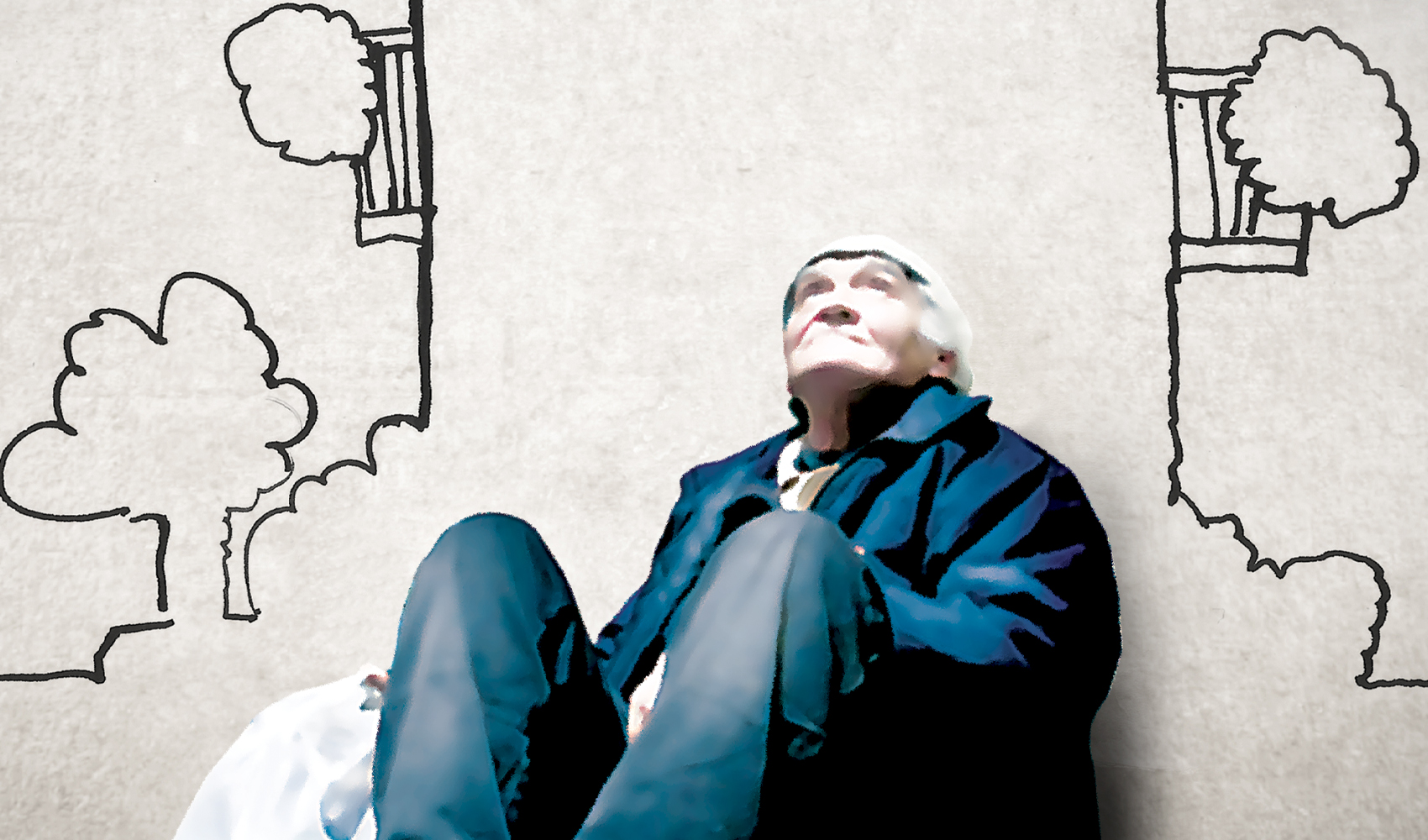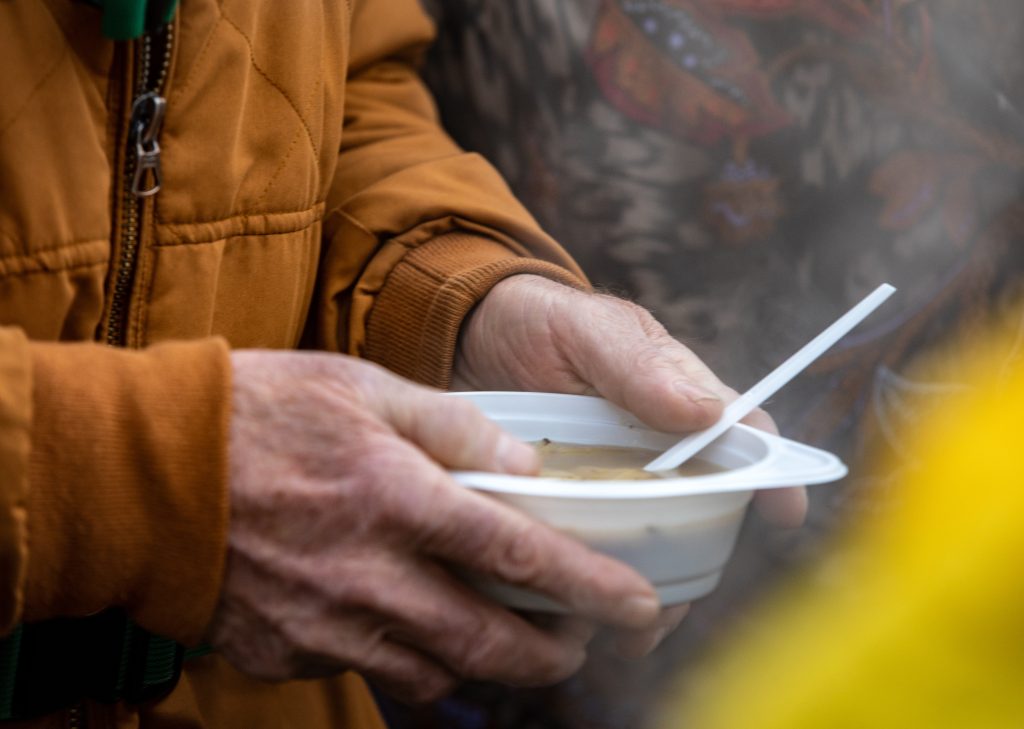
Crystal and G, a married couple both wearing tan Carhartt overalls, sit on a bench at the Boulder Bandshell on a sunny Thursday afternoon.
They’ve been homeless for just under a year. Their sleeping bags and backpacks sit next to them. Crystal says they were turned away from the shelter just last night, a regular occurrence.
She describes accessing services as “a hamster wheel,” a constant struggle of figuring out where to be and when, and figuring out a way to get there.
“You don’t know what you’re looking for? You’re screwed. That’s where I’ve been — just going in circles, chasing my tail,” Crystal says. “I don’t know the questions to ask everybody, and everybody’s so busy.”
She describes the slog of getting to the right place at the right time: “Back and forth, back and forth. That’s a pain in the rear end, and it hurts. You’re gone for a couple hours, but it feels like you just went to work and did manual labor.”
That could be changing soon as plans to bring a range of services under one roof at Boulder Shelter for the Homeless (BSH) progress. City Council made a day center a priority at their 2022 retreat. Previous plans for the center on Folsom fell through after the developer withdrew from the project in July 2023, and in December 2023, the City and BSH announced plans for the day center in the existing shelter facility.
“The best practice in this work is to co-locate services so people don’t have to bounce all around the city to access services, but rather have a one-stop shop where they can access several services in one place,” says Megan Newton, the City’s homelessness policy advisor.
Crystal says she found out about the day services center by mistake — she was searching for services when she came across an article in which housed neighbors lamented potential property loss values. Crystal and G see the co-location of services as largely positive.
“I personally don’t care to be out in the streets by myself, not knowing where I’m going,” Crystal says. “We can’t both get a job, because you can’t keep [your stuff] in the locker with how big they are. I don’t know how to fit this with my other stuff. So are we supposed to just throw it all away and say, ‘OK, I’ll just wear the same underwear for the next two weeks?’”
G sits behind Crystal with his arms wrapped around her. They say they keep each other going.
“As long as it’s at the shelter itself, then I can go to work, and I ain’t got to worry about her having to pack all our stuff up every day and walk these streets and tote our stuff,” G says. “I mean, yeah, that would be a good thing.”
For the City and shelter, the day center is a piece of the puzzle in addressing Boulder’s growing homelessness crisis.
“The ultimate goal is to get engaged folks into services in an effort to exit them from homelessness altogether,” says Newton. “This is just another piece of a full continuum to be able to do that.”
It’s a work in progress, and City staff approval is still required for the center to move ahead, but here’s what we know — and what we don’t — about the day center so far.
What we know
The center will provide a dedicated space for the unhoused to go during the day — something that hasn’t existed (other than during critical weather) in the city since 2017. The hope is that it will engage a new population of people who, for a variety of reasons, don’t come to the congregate nighttime shelter.

“The big plus for us is that we have a place and an attraction for those people so that we can get them connected to services that already exist,” says Andy Schultheiss, a spokesperson for the shelter. “Whether that’s mental health or substance abuse or job searching or connecting with lost relatives and all of these things that we do normally, we can only do that for people who show up for our nighttime services.”
Reaching those new people isn’t without its hurdles.
“Dealing with a whole new population that isn’t used to the rules that we have in the shelter — that’s going to be a bit of a challenge, and we’re gonna have to work through that, working with the police department and others and figure out what those rules are going to be,” Schultheiss says. “All these things are overcomable, they’re just going to take a little while.”
Funding for the day center is coming from several different sources. The City’s general fund will contribute $2.6 million for the next five years to pay for ongoing day service center expenses as well as housing and capital supports. After that, the City will pay $1.6 million annually, according to Lyndsy Morse-Casillas, a spokesperson for the City.
Of the City’s general fund contributions, $108,000 will go toward 30 housing vouchers that the state is helping to fund. City funding is also being supplemented with a one-year state grant of more than $1.2 million for expanded services in 2024, which includes additional case management services, a second retention team, peer support and mental and behavioral health services.
A $2 million two-year grant from the state’s Department of Local Affairs along with “some general fund” money will cover a new respite program, according to Morse-Casillas.
Staff also “expect to request funding during the mid-year process to support renovations and startup costs for both respite and day services,” according to Morse-Casillas.
Some neighbors aren’t happy. In a nearly two-hour long Good Neighbor Meeting, a required part of updating the management plan, most of the more than 20 neighbors that spoke expressed concerns about the shelter adding day services.
“Had I known this was going to happen, I would have highly reconsidered buying considering the price that it cost to live in this neighborhood,” said Dakota Ridge resident Emily Metsa at the meeting. “Safety is a huge issue. Loitering is happening beyond your property as people leave the property.”
Schultheiss believes having a day center will likely reduce loitering.
“Right now, we have a situation where people are kicked out, and they typically hang around for a while before getting on a bus or walking downtown or whatever they have to do that day,” he says. “And then the same thing happens in the evening — there’s a line around the block of people waiting to get into the shelter.
“If we’re open 24/7, those people are going to be inside. And yes, it’s true that people are going to come and go a little bit during the day, but I think that will be balanced by people who aren’t just waiting around at the beginning and end of the day with no place to go.” The management plan allows for people to come and go during the day — a deviation from how the night shelter operates, with no coming and going allowed.
Crystal echoed Schultheiss’ sentiment.
“They don’t want us around and sleeping here and there,” she says. “Well, then give those who want it the opportunity to change all that. You know, help us help you help us.”
Transportation to the shelter will double. Currently, free transportation to the shelter consists of one HOP bus from the shelter in the morning and one to the shelter in the evening.
The shelter is at the terminus of the SKIP and HOP lines, and Newton says in addition to doubling the free buses to the shelter, the City also plans to provide bus passes.
“Although there will be free buses running, folks don’t have to wait necessarily for that bus, but rather would have access to bus passes both at the day center and from outreach teams,” Newton says.
The day center comes with increased capacity at the night shelter year round. The shelter’s 160 beds will be increased to 180 beds every night. Previously, those extra 20 beds were only available during critical weather events. Moving forward, no additional beds will be added for critical weather.
The shelter needs to hire more people. Schultheiss says a big part of the shelter’s focus right now is hiring more staff and figuring out shifts to meet the increased hours. Currently, the shelter employs 70 people, 50 of whom are client facing at the shelter or other permanent housing sites. Ideally, the shelter will hire between five and 10 new employees, Schultheiss says.
“Our client-facing staff are amazing, and they don’t get paid all that well. It’s tough work,” he says. “We’re constantly hiring people for the night shifts, and now we’ve got to do the same for the day shifts. So that is a big, big lift for us.”
What we sort of know
When the shelter will open. The goal is for the shelter to open by the end of winter, but Spencer Downing, chief housing officer at BSH, says spring is a safer estimate.
The services that will be offered, but not when they’ll be offered. The full list of proposed services includes respite care for those transitioning from the hospital, community court and treatment for substance abuse, but not all those services will necessarily be available from the outset.
Coordinated Entry and diversion programs such as those that help people reconnect with family members will be available right away, Schultheiss says.
“It’s amazing how many people would go live with their cousin in Kentucky or wherever they’re from if they had fare to get there and a nice set of clothes and all that. So we do that,” he says.
Services to help get folks who qualify into permanent housing will also start on day one, according to Schultheiss. Showers, laundry and lockers — all of which the shelter already has — will also most likely be available from the start.
Lunch is an evolving discussion, but Schultheiss says it will probably be available shortly after the opening of the day services center.

“We’re going from 110,000 meals a year to 160,000 meals a year, which is an enormous thing, and food storage is a huge headache,” Schultheiss says. “We don’t have that much room here.”
Crystal says she thinks having lunches available will be an important factor in whether the center is utilized.
“I hope that it’s doing breakfast and lunch, so that we’re fed,” she says. “Because otherwise, the day center is going to be, more or less, not really utilized as much without the food there, because then we have to go out and look for food.”
Bringing in outside partners such as mental health and substance abuse service providers is currently the biggest question mark and will happen “more slowly,” Schultheiss says. The plan is for the entire management staff of the shelter to move their offices out of the shelter to make room for service providers.
“It’s going to happen at some point, but perhaps not on day one,” he says.
Putting the day center in the existing shelter saves time and money. Having the day center in a separate location would have likely required additional costs to buy or lease space. Schultheiss says because of those savings and additional funding that comes with the day center, BSH will be able to nearly double the number of people in permanent housing over the next year.
“Past that, we expect there will be savings,” Newton says, “but until we do it, we’re not quite sure where that lies.”
Since a new building or renovations to an existing building are no longer needed, the City also expects the center to open six to 12 months earlier than if it was in a new location, Morse-Casillas says.
What we don’t know
What intake at the shelter will look like. Currently, those hoping to stay at the shelter must arrive between 5 and 7 p.m. and have completed the Coordinated Entry process ahead of time. On nights when the shelter is at capacity, a lottery system is used to decide who gets a bed.
With the shelter’s new hours and services, that protocol will likely change. Schultheiss says those plans are in development, but likely won’t be nailed down until the final permit is submitted to the City.
Whether the shelter will update the management plan before resubmitting to the City. Some speakers at the Good Neighbor Meeting said they feel that NoBo bears the brunt of a disproportionate amount of homelessness services. Others said they felt the process was rushed and like the meeting was “just checking a box” rather than meaningfully engaging.
It’s true that the Good Neighbor Meeting doesn’t actually require any additional action on the part of the shelter or the City. Updating the management plan requires a staff-level review, and it’s unlikely it won’t be approved since the center already has support from the City. Still, Schultheiss says it’s possible there will be another update to the management plan based on neighbors’ feedback.
How the new services at the day center will be received by homeless folks. Consolidating services is good. It makes them more accessible and easier to navigate.
But until the center is up and running, it’s hard to say how many people will access the services a day and how many of those people will be new to the services.
“Different day centers have had different experiences in terms of how many people come in. We don’t really know,” Schultheiss says. “There will be people here, but I very much doubt there will be 180 people there unless there’s a blizzard going on. We’d be very, very pleased if we could serve 30 or 40 people a day and get them into meetings with service providers.”
For some, the fact that the day center is in the same location as the night shelter could be a turnoff.
“I think everyone in this process hopes that we will be able to create opportunities for people who often had been reluctant to go to the shelter, or have had difficulty with the shelter or finding the shelter and appealing to them,” says Downing. “One of the things that we were looking forward to in creating a separate space was the opportunity to have a place that didn’t have those associations.”

Brittany Ann, who’s been homeless for a little over four years, says she’s stayed at the shelter before but is unlikely to go back even for day services except in critical weather.
“I feel like the shelter is too many people in one place,” she says. “All we have in common is that we don’t have anywhere to be, so you end up with all of this cultural turmoil and stress, and it’s a really poor environment.”
Figuring out how to reach people like Brittany Ann who are wary of the shelter is one of the biggest questions staff are working to answer, Downing says.
“How do we make this resource attractive and, above all, useful to people experiencing homelessness [so] that we can be a piece of solving whatever they need that gets them into housing,” he says. “Like, how do we make it useful to that person who is annoyed with bureaucracy? How do we make it useful to that person who is suspicious of the helper industry? I say that as somebody who is part of the helper industry, and how can we be useful to those people?”
What’s next?
After the shelter resubmits the management plan, it will be reviewed on a two-week track, and staff could require a third round of review, according to Morse-Casillas.
All in all, City and shelter staff acknowledge they don’t have all the answers yet — and likely won’t until the center is operational.
“When Disney World was created, Walt Disney decided not to pave the sidewalks. Instead, he waited a couple of years to see where the visitors were gonna walk, and then he paved those,” Schultheiss says. “So that’s kind of what we’re going to do. We’re going to see how this goes, and we’re going to stay in close touch with the neighborhood, and we’re going to figure out what’s the best way to do it, and then we’re going to pave those paths.”
For Crystal, input from those with lived experience will be crucial.
“They want to know where to start to fix it? They need to start asking people who are homeless and listening to what they have to say.”
Editor’s note: The homeless individuals featured in this story asked to be identified by their first names only.
